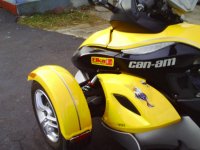spyder stryder
New member
fox shocks review
As for the shocks if each brand has the same valving on compression & rebound there would be no difference in
how they control the roll or the sway of the spyder. This is controled by the anti roll bar & the spring rate.The
shock will control how fast the weight rolls from side to side as in roll over & rebound back. In stock form the
spring & shock package is on the soft side for high speed handeling an it gives the spyder a floating around feel.
As the spyder sits in stock form lets say the lower & upper arms are level with each other & the ground.This will
give what is refered to as ground level roll cener height. If the spyder has a center of gravity height of lets say 40"
above ground with a 0" roll center then you will have a 40" moment arm which will cause it to roll a lot very easy.
If you raise the spyders ride height up the inner piviot points will raise heigher than the outer piviot points & this
will lower the roll center. Lets say it drops 2" below the ground level with the same center of gravity height you will
now have a moment arm of 42" & this will cause the spyder to try & roll more ( longer lever to pull weight over).
If the spyder was lowered so the inner piviot points drop below the outer point the roll center will raise up. Now
lets say it is 3" above the ground with the center of gravity at 40" then you will have a moment arm of 37" &
less leverage to pull the weight over thus less roll. Keep in mind the anti sway bar & springs control how much it rolls
& The shocks control how fast the roll happens & how it rebounds. No matter if two shock companys or ten companys
are building the shocks if they use the same valving you will have the same results or so close 99.9% of the guys can't
tell the difference.I bet this will open a very large can of worms & probley even hurt some feelings. A complete tuned
suspension will out work a half azz on any day.Just be careful about going to far as you will get some bad results.
spyder stryder
As for the shocks if each brand has the same valving on compression & rebound there would be no difference in
how they control the roll or the sway of the spyder. This is controled by the anti roll bar & the spring rate.The
shock will control how fast the weight rolls from side to side as in roll over & rebound back. In stock form the
spring & shock package is on the soft side for high speed handeling an it gives the spyder a floating around feel.
As the spyder sits in stock form lets say the lower & upper arms are level with each other & the ground.This will
give what is refered to as ground level roll cener height. If the spyder has a center of gravity height of lets say 40"
above ground with a 0" roll center then you will have a 40" moment arm which will cause it to roll a lot very easy.
If you raise the spyders ride height up the inner piviot points will raise heigher than the outer piviot points & this
will lower the roll center. Lets say it drops 2" below the ground level with the same center of gravity height you will
now have a moment arm of 42" & this will cause the spyder to try & roll more ( longer lever to pull weight over).
If the spyder was lowered so the inner piviot points drop below the outer point the roll center will raise up. Now
lets say it is 3" above the ground with the center of gravity at 40" then you will have a moment arm of 37" &
less leverage to pull the weight over thus less roll. Keep in mind the anti sway bar & springs control how much it rolls
& The shocks control how fast the roll happens & how it rebounds. No matter if two shock companys or ten companys
are building the shocks if they use the same valving you will have the same results or so close 99.9% of the guys can't
tell the difference.I bet this will open a very large can of worms & probley even hurt some feelings. A complete tuned
suspension will out work a half azz on any day.Just be careful about going to far as you will get some bad results.
spyder stryder

